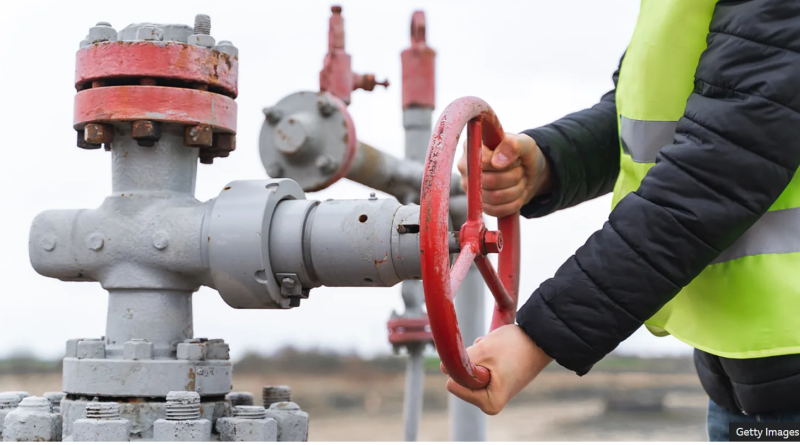The health impact of living near a fossil gas leak

Leaked methane is helping scientists map toxic threats to health.
At the very base of the United States, straddling the border between Texas and New Mexico, lies the Permian Basin. Formed around a billion years ago, the region’s ancient deposits of organic matter have, in modern times, provided a vast reserve of oil and gas. But some say that for the communities drawn to the jobs and opportunities in this desert landscape, there is a high price to pay.
Jozee Dominguez Zuniga is a 22-year-old grass roots organiser who lives in Eddy County, New Mexico. Her family has no less than six gas pipelines running through the back of their property. There is also a fracking site "around two miles" down the road, Zuniga says, and active oil rigs are within sight of the local primary school, health clinic and senior centre. When she stands outside in the street at dusk, what appears to be a "huge fire" lines the horizon, she says: rows and rows of flares burning off excess gas from oil wells.
For Zuniga, living among all this fossil fuel infrastructure raises an urgent question: could it be making her and her community sick?
"I'm 22 and I don't want to have children," Zuniga says, adding that she feels she would be putting them at risk of poor health.
While it is difficult to answer that question for individuals living near pipelines or oil rigs, a range of studies suggest that pollutants from oil and gas production can indeed pose health risks.
According to researchers at the University of North Carolina, venting and flaring by the US oil and gas industry releases pollutants that lead to 710 premature deaths and 73,000 childhood asthma exacerbations each year – racking up a health bill of $7.4bn (£5.8bn). When this is extended to air pollution from other parts of the oil and gas lifecycle in the US – including production, transportation and storage, but not combustion or indoor gas-leaks – further research has calculated the total impact results in an estimated 7,500 excess deaths and a $77bn (£61bn) annual health bill.
Finding ways to identify high concentrations of air pollutants is an urgent concern for many in her community, Zuniga says. Local residents watch closely for local or state-wide news reports of emissions leaks from the surrounding infrastructure. They've also installed their own air monitors in numerous backyards to keep tabs on the air quality in relation to the legal limits.
New technologies, however, could soon help worried communities like Zuniga's – by mapping outdoor gas leaks and showing more clearly where there may be exposure to harmful emissions.
Health hazard
Of the various chemicals found within natural gas, methane is the largest – making up around 70-90% of its composition. Although not in itself directly harmful to health, it results in the formation of ground level tropospheric ozone, a harmful air pollutant; and it is a relatively easily detectable indicator of gas emissions in general. This latter trait makes it particularly useful to those hoping to track toxic releases from the gas industry.
There is another crucial reason to measure methane leaks: methane is second only to CO2 in fuelling climate change. Methane abatement in the fossil fuel sector could prevent around one million premature deaths globally from ozone exposure through 2050, according to one estimate.
Methane can be found in gas leaks from various sources: appliances in homes, abandoned wells, and mega-leaks from explosions or equipment malfunction. All such sources also release a number of toxic co-pollutants alongside methane. These include volatile organic compounds, such as the hydrocarbon benzene, which can lead to cancer, and nitrogen dioxide, which can trigger a range of respiratory diseases as well as lung cancer, preterm birth and diabetes.
People can thus be exposed to harmful chemicals at various stages of the oil and gas life cycle, from production to consumption. Gas stoves - which are used in about 50 million US homes – can cause indoor concentrations of toxic chemicals to rise, while burning fuels in cars, power plants or for heating can lead to pollution outdoors. Large cities such as Chicago and New York record high outdoor concentrations of harmful nitrogen oxide and fine particulate matter, especially near heavily travelled roads.
Yet further upstream parts of the oil and gas life cycle, including pollution from transmission in pipelines, also play a part. "The highest concentrations of these non-methane hydrocarbons are in gas at wellheads, which also have the highest emission rates," says Amy Townsend-Small, a professor and climate scientist at the University of Cincinnati in Ohio, who has researched pollution in Fort Worth, Texas.
"Most people in the world are going to be exposed through gas distribution systems and through their household gas appliances, and in some places people are exposed to all sources," says Seth Shonkoff, executive director at PSE Healthy Energy, an independent research institute. "The entire oil and gas supply chain is present among people's homes," he notes of parts of Los Angeles, Texas, and other oil and gas producing regions.
Mapping the methane
Methane is the easiest substance to detect within gas's many compounds, says Shonkoff: if you map the release of methane, you'll nearly always catch the other chemicals, too. However, methane monitoring is not a given: "we don't accurately know how much methane is leaking, either in the US or globally," says Jeni Miller, executive director of the Global Climate and Health Alliance. New technology is helping to map this threat.
On the ground, FLIR optical gas imaging cameras use infrared to spot leaks of methane that are invisible to the naked eye. Above the Earth's atmosphere, satellites are using emerging sensing technology to alert leaks on an ever more detailed scale: in March, the Environmental Defense Fund launched MethaneSat, which experts say will aid data collection on methane emissions from the fossil fuel industry.
Together, these advances in detection should support the development of improved assessments and solutions to leaky infrastructure – from repair to replacement – says Miller.
At PSE Healthy Energy, Shonkoff's team have also been aiding this mapping effort by collecting natural gas samples from pipeline systems throughout the world and measuring their toxicity. Later this year, they will roll-out a Methane Risk Map. This interactive, online resource will show the various compositions of natural gas in different locations, and so help people estimate their exposure to toxic leaks, Shonkoff explains.
"If there’s a methane leak observed in the middle of the Permian basin in Texas, or the middle of downtown LA, or the middle of London – we will know what that gas is made out of in these places," Shonkoff says. The resulting air quality model their map will produce will show each plume of gas as it moves across a landscape, and not only share its concentration of methane and benzene, but also who is at risk of exposure.
"One of the interesting things about natural gas leakage is that it’s not a single pollutant regulated by a single agency," Shonkoff adds, noting that, so far, methane has primarily been regarded as a climate issue. "But one of the impacts our tool is likely to bring is to make clear to air quality agencies and regulators that they now have skin in the game; that they need to get to address these leaks and the people breathing degraded air because of them."
Race to reduce
Phasing out fossil fuels is the surest way to reduce natural gas's toxic threat, Miller and others say. But the transition to 100% clean energy sources will take time. So numerous groups are also pressing for facilities near neighbourhoods and communities to be removed, and for the energy sector to rapidly reduce methane emissions from existing production, something that can be done quickly and at low or no net cost, says Miller.
At a policy level, the US government issued a new rule in 2023 designed to reduce methane emissions from natural gas operations. Further afield, Norway has regulations to prevent gas flaring and Nigeria has recently adopted guidelines for flaring and methane leakage.
Back in Eddy Country, New Mexico, Zuniga says she is so worried that she would like to leave her town, but is staying for the sake of her family. She is not hopeful that things will change.
On a global level, there are signs that the international community is taking steps to reduce methane emissions from existing fossil fuel production and use (as well as other sectors): 155 countries are now signed up to the 2021 Global Methane Pledge, which commits to collectively reducing methane emissions 30% by 2030 (relative to 2020 levels).



